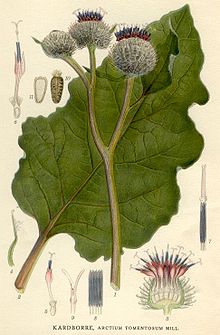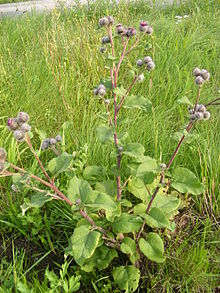Felt burdock
| Felt burdock | ||||||||||||
|---|---|---|---|---|---|---|---|---|---|---|---|---|

Felt burdock ( Arctium tomentosum ) |
||||||||||||
| Systematics | ||||||||||||
|
||||||||||||
| Scientific name | ||||||||||||
| Arctium tomentosum | ||||||||||||
| Mill. |
The felt burdock or Woolly Burdock ( Arctium tomentosum ) is a plant of the genus burdock ( Arctium ) in the subfamily of Carduoideae within the family of Compositae (Asteraceae).
description

Appearance and foliage leaf
As with the other species of the genus, the felt burdock is a biennial herbaceous plant that usually reaches heights of 50 to 120, sometimes up to 250 cm. The stem is usually sparsely branched.
The alternately arranged leaves are always divided into a petiole and a leaf blade, which is more or less densely tomentose on the underside. The basal leaves have hollow or solid, 10 to 15 cm long petioles with glandular hairs and white woolly hairy on the underside and green and sparsely haired leaf blades on the upper side, which are 30 to 40 cm long and 16 to 28 cm wide as well have a roughly toothed to almost smooth leaf margin.
Inflorescence, flower and fruit
In umbrella-clustered total inflorescences, the cup-shaped partial inflorescences stand together over a length of 1.5 to 12 cm, relatively long inflorescence shafts . The felt burdock can be immediately distinguished from the other types of burdock by the cobweb-like, woolly, hairy flower heads. The flower heads have a diameter of 1.5 to 2.5 cm and a height of 3 cm. The bracts are linear to linear-lanceolate; the inner ones are usually purple in color and have a border with tiny, spread out or bent back glandular hairs. The reddish or whitish tip of the bracts can be curved in a hook shape or straight.
There are many tubular flowers (over 30) in the flower heads . The mostly pink-purple, rarely white, flower crowns are 9 to 13 mm long with a tiny, glandular tongue.
The light brown achenes are 5 to 8 mm long. The pappus consists of 1 to 3 mm long bristles.
Chromosome number
The number of chromosomes is 2n = 36.
Occurrence
The felt burdock is originally found in Europe, Central Asia, Siberia and Xinjiang . In North America and Armenia it is a neophyte . It grows in not too dry ruderal places such as roadsides, rubble or field margins, preferably near banks. It thrives particularly on fresh, nutrient-rich and base-rich, preferably calcareous, more or less humus-rich, sandy-stony or pure loam or clay soils. It occurs in Central Europe mainly in the Leonuro-Ballotetum, is a character type of the association Arction lappae, but is also found in societies of the association Onopordion acanthii or the subclass Galio-Urticenea. In the Allgäu Alps, it rises in the Vorarlberg part near Neßlegg near Schröcken up to an altitude of 1420 meters.
use
The felt burdock is edible and can be used in the same way as the closely related burdock .
literature
- Werner Rothmaler : Excursion flora from Germany vascular plants: basic volume . 18th edition. Spektrum Akademischer Verlag, 2002, ISBN 3-8274-1359-1 , page 469
- David J. Keil: Arctium : Arctium tomentosum - the same text online as the printed work , In: Flora of North America Editorial Committee (Ed.): Flora of North America North of Mexico , Volume 19, Magnoliophyta: Asteridae, part 6: Asteraceae, part 1 (Mutisieae – Anthemideae). , Oxford University Press, New York a. a., 2006. ISBN 0-19-530563-9 (section description)
Individual evidence
- ↑ a b c d e Werner Rothmaler : Excursion flora from Germany vascular plants: basic volume . 18th edition. Spektrum Akademischer Verlag, 2002, ISBN 3-8274-1359-1 , page 469
- ↑ a b c d e f g h i David J. Keil: Arctium : Arctium tomentosum - the same text online as the printed work , In: Flora of North America Editorial Committee (Ed.): Flora of North America North of Mexico , Volume 19, Magnoliophyta: Asteridae, part 6: Asteraceae, part 1 (Mutisieae-Anthemideae). , Oxford University Press, New York a. a., 2006. ISBN 0-19-530563-9
- ^ A b Arctium in the Germplasm Resources Information Network (GRIN), USDA , ARS , National Genetic Resources Program. National Germplasm Resources Laboratory, Beltsville, Maryland. Retrieved March 15, 2018.
- ^ Erich Oberdorfer : Plant-sociological excursion flora for Germany and neighboring areas . With the collaboration of Angelika Schwabe and Theo Müller. 8th, heavily revised and expanded edition. Eugen Ulmer, Stuttgart (Hohenheim) 2001, ISBN 3-8001-3131-5 , pp. 960 .
- ↑ Erhard Dörr, Wolfgang Lippert : Flora of the Allgäu and its surroundings. Volume 2, IHW, Eching 2004, ISBN 3-930167-61-1 , p. 631.
- ↑ Rudi Beiser: Our edible wild plants . Franckh-Kosmos , Stuttgart 2018, ISBN 978-3-440-15910-1 , p. 126 .
Web links
- Arctium tomentosum Mill., Felt burdock. In: FloraWeb.de.
- Felt burdock . In: BiolFlor, the database of biological-ecological characteristics of the flora of Germany.
- Profile and distribution map for Bavaria . In: Botanical Information Hub of Bavaria .
- Arctium tomentosum Mill. In: Info Flora , the national data and information center for Swiss flora . Retrieved June 11, 2016.
- Distribution in the northern hemisphere
- Thomas Meyer: Klette data sheet with identification key and photos at Flora-de: Flora von Deutschland (old name of the website: Flowers in Swabia )


